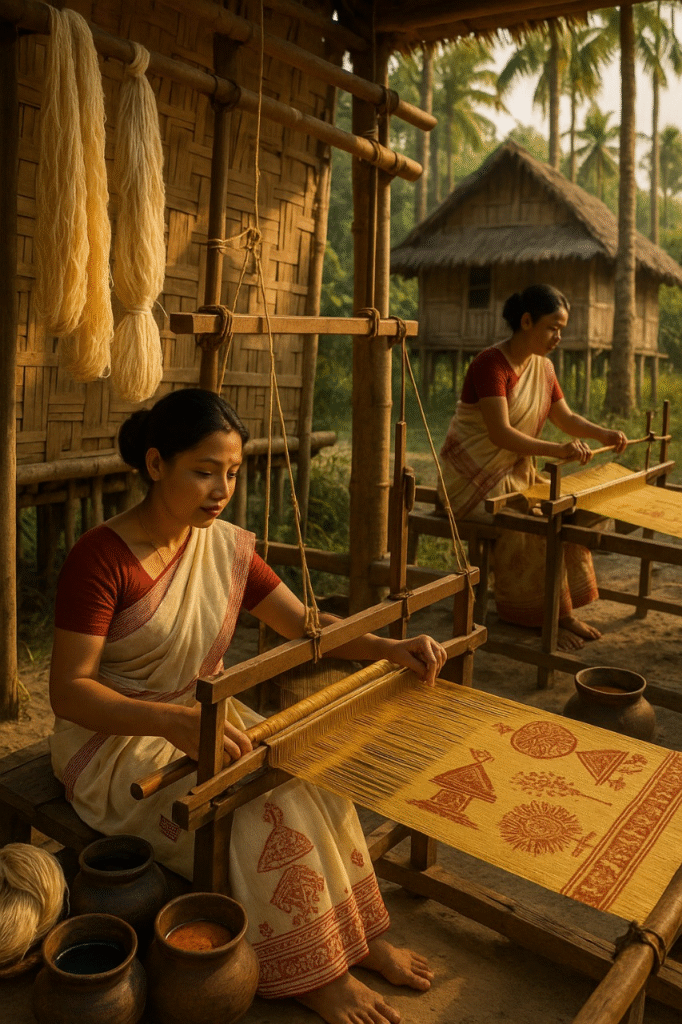“We honour hands that weave not just fabric but culture.” — Assam CM on National Handloom Day
On August 7, 2025, Assam joined the nation in celebrating the 10th National Handloom Day, paying tribute to the artistry, resilience, and cultural significance of its weaving community. The celebration also marked the state’s unmatched contribution to India’s handloom sector—a legacy woven through tradition, skill, and community pride.
History of National Handloom Day
National Handloom Day was first observed in 2015 by the Government of India to honour the contribution of handloom weavers to the country’s cultural and economic fabric. The date August 7 was chosen to commemorate the Swadeshi Movement of 1905, a historic campaign that urged Indians to boycott foreign-made goods and embrace indigenous products, especially handwoven textiles. The Swadeshi Movement was not just a political call; it was a cultural awakening. Weavers and artisans across India became symbols of self-reliance, producing fabrics that reflected the nation’s soul. Since then, National Handloom Day has grown into an annual celebration of this craft, aimed at preserving traditional weaving techniques, promoting sustainable fashion, and ensuring the welfare of artisans.

Assam’s Handloom Legacy
The handloom sector is, indeed, one of Assam’s oldest and most vibrant cultural identities. Known globally for its Muga silk, Eri silk, and intricate traditional cotton weaves, Assam has, moreover, preserved its heritage through generations of skilled artisans. These fabrics are not just cloth; rather, they are carriers of history, symbols of identity, and sources of livelihood for thousands of rural households. Thus, the craft not only reflects the rich culture of the region but also plays a crucial role in sustaining the economy and empowering communities.
With over 12 lakh weavers, as per the 2019–20 survey, Assam has the highest number of handloom artisans in India. The majority are women, making handloom weaving both a cultural tradition and a powerful tool for women’s economic empowerment.
Highlights of National Handloom Day 2025 in Assam
- Empowering Women Weavers: The Self-Reliant Women scheme, furthermore, continues to directly purchase handloom products from women across various ethnic communities, such as the Bodo, Karbi, Mising, Rabha, and Koch-Rajbongshi. By eliminating middlemen, the initiative not only ensures fair earnings for these women but also empowers them financially. Additionally, this scheme promotes the rich cultural heritage of these communities, allowing their unique crafts to gain visibility and appreciation in the market. Thus, it plays a crucial role in fostering both economic independence and cultural pride among self-reliant women.
- Promotion Through Culture: During Rongali Bihu, Chief Minister Himanta Biswa Sarma gifted locally made Phulam Gamucha, a move that promoted daily use of traditional textiles.
- Recognizing Excellence: Many Assamese artisans have won prestigious awards like the National Weaver Award and Sant Kabir Award, highlighting their exceptional craftsmanship.
- Legal Safeguards: Under the Handloom (Products Preservation) Act, 1985, 11 traditional fabrics, including Gamusa, Mekhela-Chador, and Dokhna, can only be produced using handlooms.
- GI Tag Recognition: Muga silk, Assamese Gamusa, Mising handloom products, and five traditional Bodo textiles—Dokhna, Bodo Eri Silk, Bodo Gamusa, Jwmgra, and Aronai—have secured Geographical Indication (GI) tags for authenticity.
- Cultural Tribute in Fashion: Renowned designer Sanchita Dutta created a symbolic handwoven garment featuring an image of PM Narendra Modi, honouring his dedication to the handloom sector.
- Showcase Event: The North Eastern Handicrafts and Handloom Development Corporation Ltd. organized a special program at the Craft Promotion & Experience Center, Guwahati, attended by Minister Bimal Borah, who called handloom products “symbols of identity, self-reliance, and national pride.”
The Heart of Assam’s Handloom Sector
- Economic Backbone of Rural Areas:
Handloom weaving provides direct employment to lakhs of households across Assam, making it one of the largest unorganized sectors in the state. - Women-Centric Industry:
Over 80% of Assam’s weavers are women, making this craft a major driver of rural women’s empowerment. - Diverse Ethnic Contributions:
Every community—from Bodos and Mishings to Karbis and Rabhas—contributes unique motifs, patterns, and techniques that enrich the state’s textile heritage. - Sustainability & Slow Fashion:
Assam’s handloom products are eco-friendly, sustainable, and promote slow fashion—a growing global trend. - Cultural Identity:
Iconic textiles like the Gamusa, Mekhela-Chador, and tribal weaves are deeply tied to festivals, rituals, and everyday life in Assam.
Challenges Facing Assam’s Handloom Sector
While Assam’s weaving heritage remains strong, several challenges hinder its full potential:
- Declining Interest Among Youth: Younger generations are moving towards other professions due to lower income prospects in weaving.
- Competition from Power Looms: Mass-produced textiles often undercut handloom products in price, making it harder for artisans to compete.
- Limited Market Access: Many rural weavers rely on local fairs and middlemen, missing out on larger national and international markets.
- Rising Raw Material Costs: Silk, cotton, and natural dyes are becoming expensive, squeezing the margins of small-scale weavers.
- Lack of Modern Design Integration: Traditional designs sometimes fail to appeal to urban and global buyers without contemporary styling.
The Way Forward
To sustain and grow the sector, a balanced approach is needed:
- Skill Development & Design Innovation:
Training programs can blend traditional techniques with modern design trends to attract a wider customer base. - Digital Marketing Support:
Helping weavers sell directly through e-commerce platforms can eliminate middlemen and expand their reach. - Financial Assistance & Subsidies:
Government-backed low-interest loans and subsidies for raw materials can make weaving more profitable. - Youth Engagement:
Special incentives, workshops, and competitions can encourage young people to take pride in weaving as a career. - Stronger Brand Positioning:
Promoting Assamese handloom as a premium, eco-friendly, and culturally rich product can help it stand out in global markets.
Conclusion
National Handloom Day 2025 was not just a date on the calendar—it was a celebration of Assam’s weaving heritage, an industry that weaves together tradition, identity, empowerment, and pride. As the state works to overcome challenges and embrace innovation, the hands of Assam’s weavers will continue crafting fabrics that tell stories—stories of resilience, culture, and belonging.
FAQs on National Handloom Day & Assam’s Handloom Sector
A: It marks the launch of the Swadeshi Movement in 1905, which promoted the use of indigenous products, especially handlooms.
A: Assam is renowned for its Muga silk, Eri silk, Assamese Gamusa, Mekhela-Chador, and diverse tribal weaves.
A: As per the 2019–20 survey, Assam has over 12 lakh weavers, the highest in India.
A: Key initiatives include the Self-Reliant Women scheme, GI tagging of products, and state support for direct marketing.
A: They protect traditional designs from imitation, ensure authenticity, and help products gain national and international recognition.
CITATIONS
- Assam Observes National Handloom Day With Special Event In Guwahati
- Threads of pride: Assam weaves glory into National Handloom Day
- National Handloom Day
Also Read












